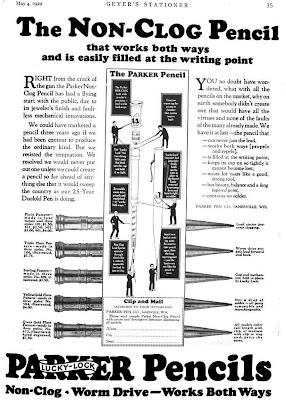This article has been edited and included in The Leadhead's Pencil Blog Volume 5; copies are available print on demand through Amazon here, and I offer an ebook version in pdf format at the Legendary Lead Company here.
If you don't want the book but you enjoy this article, please consider supporting the Blog project here.
The barrel is a little ratty, and it’s easy to miss that this is an early Parker “Lucky Lock” pencil, since the imprint is fairly inconspicuous, stamped on the cap:
Parker called these the “Lucky Lock” as a play of words on the company’s “Lucky Curve” feed; the name referred to the way in which the cap was secured to the end of the barrel by two little tabs on either side of the top of the pencil:
To remove the cap, push down and twist to disengage those tabs from the inside of the cap, and it springs right off. In theory – the design flaw which doomed the Lucky Lock cap to a very short run is that if an eraser is installed which is just a little too long, it’s impossible to push the cap down far enough to disengage it, and you’re stuck with a pencil with a cap that won’t come off. Compounding Parker’s mistake, when the company switched over to a cap which simply pulled off, they didn’t appear very different from the outside – I believe many Lucky Locks were damaged or destroyed by unsuspecting owners trying to wrestle the caps off by pulling rather than pushing.
Parker introduced the Lucky Lock in 1922 - a trade announcement of its pending release was printed in the November 19, 1921 edition of The American Stationer:
The company also flirted with calling them the Parker “Non-Clog,” as shown in this advertisement in the August, 1922 edition of Office Appliances:
And also in the May 4, 1922 edition of Geyer’s Stationer:
As both pieces note, the Parker Lucky Lock was originally offered only in bare metal finishes, in keeping with the tradition established by Wahl Eversharp and Sheaffer of pairing metal pencils with hard rubber pens.
At some point, the company decided to make something of an effort to match pencils to their pens. Catalogs from 1923 make no mention of matching pens and pencils; by the time the 1925 catalog was printed, Parker pencils abandoned the Lucky Lock feature and had barrels made of the same material as the pens.
So sometime between 1923 and 1925, Parker took its first steps towards matching pens to pencils by painting the barrels with enamel paint matching either black or red hard rubber.
Sort of . . .
This new addition is neither black nor the typical “Big Red” red. Better still is that all those nicks in the paint confirms the factory authenticity of the piece. Were it pristine, I might be inclined to think someone wanted to pimp their Lucky Lock with a flashy new paint job.
Before the show was over, I’d shown my tired little Lucky Lock to a couple Parker collectors, and asked whether the color was unusual. I didn’t get information, but I did get offers to buy it – so I suppose the answer is yes.








7 comments:
Run your question past Brian McQueen. The color could be similar to Pompeian brown, the color of the very early Duofold.
This is Jimmie Cocburn
I wrote an article about Lucky lock pencils
Someyeara ago.
Will you likethat I send it to you.
Let me know how can I dothat
The last name is Cockburn
Sure, Jimmie! My email is jveley@jonathanveley.com
Nice post dear………….keep updating!!
Promotional pen as gift
I got such a good information on this topic its very interesting one. You made a good site and I have found a similar website please check this one Key Storage Safe visit the site to know more about Safelocks.
Post a Comment